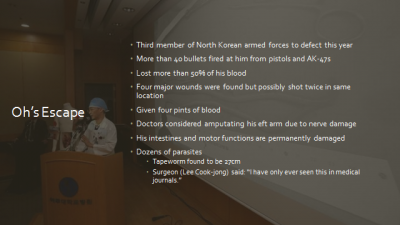North Korea
Mariella King, Upper V Alpha, is the author of the latest Stretch and Challenge presentation for Priory Post, a project on North Korea which she presented to other students and staff in November 2017. Since then has come the welcome news that North Korea is planning to participate in the Winter Olympics to be held in South Korea next month.
As one of the programmes we run at St Augustine’s Priory, Stretch and Challenge gives girls in Upper V (and this year Lower V also) a great opportunity to research a topic of their choice and is a valuable preparation for the Extended Project Qualification and A Levels in the Sixth Form. After working on their chosen topic, girls then present it to their peers and staff members.
‘For those who don’t know, I was lucky enough recently to visit Tokyo and Seoul. As you can see, I’m not going to be talking about Japan. So yes, I went to Seoul, the capital of the Republic of Korea (ROK) which lies just shy of 35 miles away from the DMZ, or Demilitarized Zone. In other words, very near the Democratic People’s Republic of Korea, or the DPRK for efficiency. We are all aware about the missile tests conducted by the DPRK in recent history and, as President Trump found out when meeting with President Xi of China, the crisis of the DPRK is “not so simple”. Hands up those who think the crisis is easy to solve?
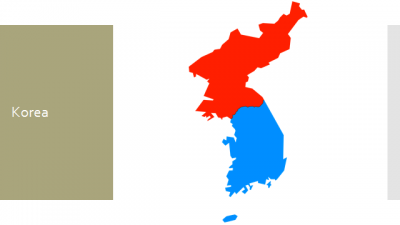
Before we talk about Korea’s current situation, let’s talk about Korea as a whole. The Korean Peninsula is bordered by Russia and China to the North, and ocean on the other side because… you know… peninsula. Korea’s total population is estimated to be around 75 million people. As my friend in Seoul explained to me, there is about 5,000 years of Korean history of the country being split into different kingdoms and being invaded. So consider that fact of constant change when thinking about the DPRK. Then there’s the obvious fact of Korea being split into two different countries, the Republic of Korea and the DPRK. The line that originally separated these two countries is called the 38th parallel which after the Korean War was shifted into what it is now.

So what’s the difference? One is North, one is South. One is communist, one is capitalist. So which one is the DPRK and which is the ROK?
Both Koreas were officially established in 1948, three years after Japan’s oppressive rule which had been in place since 1910. With Japan’s defeat in World War Two there were two things left behind in Korea: deep resentment for the Japanese, and a power vacuum. So in the midst of the Cold War, or to the non-History GCSE students the fight of communism and capitalism, the US and the USSR – or Russia – both moved in to fill this vacuum. In the South, elections were held which were won by Syngman Rhee and Kim Il Sung was appointed as the premier in the North. Kim was endorsed by the USSR while the UN only recognised the South as “a lawful government having effective control and jurisdiction”, adding “this is the only such government in Korea.“

On June 25, 1950, North Korea invaded South Korea, sparking the Korean War. The war carried on and when the UN almost saw the North Korean army unify Korea as theirs, they pushed back, led by General MacArthur. As they neared the border with China, Chinese forces intervened on behalf of North Korea, shifting the balance of the war again. Fighting ended on 27th July 1953, with an armistice that approximately restored the original boundaries between North and South Korea. After three years that saw both sides almost pushed to the brink of extinction, and massive losses among Korean civilians in both the North and the South, the war eventually reached a stalemate.
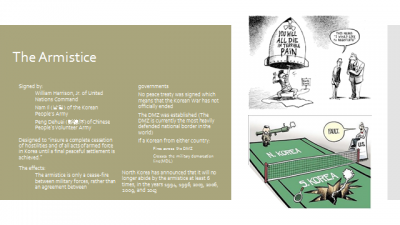
On 27th July 1953, the armistice was signed and although it affected only two countries directly – North and South Korea, the South never signed the armistice. Upon its signing Korea was split into the North and South Korea. It was designed to “insure a complete cessation of hostilities and of all acts of armed force in Korea until a final peaceful settlement is achieved,” however no “final peaceful settlement” has been achieved. In technicalities, the armistice is only a cease-fire, not a formal treaty, hence the Korean War is ongoing. The Demilitarized Zone was established to separate the two countries and is now the most heavily militarized national border in the world. Both governments have agreed that the Korean War will resume if their citizen enters the other’s side and fatally wounds the other’s citizen. Fun fact: North Korea has declared itself unbound by the armistice at least six times since 1994.

North Korea continues to be a country in this day and age, and it is a problem. For starters, North Korea’s supreme leader Kim Jong-un is a man with a fragile ego and a determination to win. The country is still communist and aggressive. Last year, North Korea held its first party meeting in an incredibly long time and reporters from other countries were invited and a North Korean woman said to a reporter asking about American policy makers, “I have nothing against Americans, its American policy makers.” About President Obama, she said, “If given the weapon I would like to shoot at him.” The country is shrouded in secrecy and the only way we hear about daily lives is through defectors. If you’d like to find out some of their absolutely amazing stories, some I’d recommend is Lee Hyeon-seo who travelled by herself through China , Park Yeun-mi and Shin Dong-hyuk. Aside from this, North Korea – as you may be able to see from the background is driven by their military.
Here are their statistics, which I don’t fully expect you to read so I’ll summarise it like this: over 25% of North Korea’s entire population is in the military.
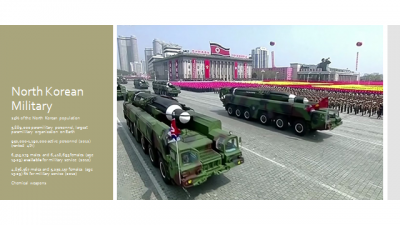
On Sunday 3rd September, as well as being the day of panic for us, just about to start the new term, it was a day of panic for the world. North Korea tested a hydrogen bomb, successfully. We know they weren’t lying this time however because seismologists in China and Japan both detected an artificial earthquake of magnitude 6.3. The payload was 120 kilotons, which if I were to describe it, is roughly 110 billion kilograms of dynamite. That makes it six times more powerful than their test last year and eight times larger than the bomb the US dropped on Hiroshima at the end of the war in 1945, which already is the largest and deadliest foreign attack.

I was fortunate enough to visit the site of Little Boy’s detonation in Hiroshima. The building here is the Shima Surgical Clinic. About 560 metres above that dome, a radius of 1 mile of the city was completely destroyed and 80,000 people were killed. Bear in mind that this was an atomic bomb and North Korea tested a hydrogen bomb, which is more compact and could fit in a missile head which could be launched over continents.

So what is happening now? South Korea’s new president, Moon Jae-in, wanted to follow the route of appeasement but is now developing a bomb to wipe out North Korea’s electrical grid. President Trump is waging a war of words and ensuring the US is rising on North Korea’s hitlist. The UN is placing sanctions and luckily for the world, China has agreed to stop exporting petroleum into North Korea and buying their textiles.
Speaking of North Korea’s hitlist, who is on it right now? Are we in the line of fire? So far, no. North Korea has threatened almost every country on earth. The US, Japan, South Korea, even Australia. But it’s fair to say that we may be safe since 1) we have not been threatened yet, 2) the DPRK team is the adopted football team of Middlesbrough, and 3) and even I was unaware they had an embassy here, in Ealing.
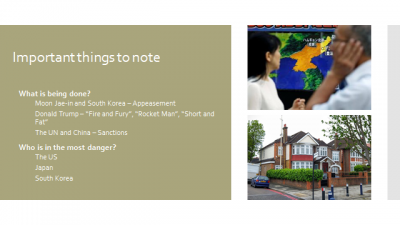
But in all of this chaos, it is easy for us to say, “Just bomb North Korea – that should do it.” But will it? Are you that unable to comprehend that perhaps, normal people live there. North Korea is incredibly dangerous – both living there and visiting. Stories we hear of life in the isolated country are horrific. As described by the aforementioned Lee Hyeon-seo, public executions are rampant and even if they are only things we could imagine in novels like 1984, they scar children until they are adults. People live in fear from speaking out since they know no one will hear them or they have been brainwashed to the point where they only know Korea as the best country on earth. But we know this to be false.
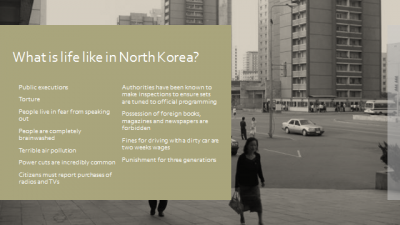
One of my friends, who used to live in Pyongyang (will you believe it), had terrible breathing problems while he was there and had to be brought back. Power cuts are so common that people work it into their daily lives, making time to get to work just in case their elevator breaks. The amount of control is almost suffocating – even the design of clothes is controlled in North Korea. Citizens must report purchases of radios and TVs. The authorities have been known to make inspections to ensure sets are tuned to official programming. Possession of foreign books, magazines and newspapers is forbidden. What is even more horrifying is the extent to which North Koreans go with punishment: fines are two weeks’ wages if you drive into Pyongyang with a dirty car. We even know of the hard labour some endure because their grandparent committed a crime.
The story of Otto Warmbier is also a chilling story. Warmbier was an American tourist in Pyongyang until he was sentenced to 15 years hard labour after being convicted for attempted theft of a propaganda poster from his hotel. One month later, he suffered severe neurological injury from an unknown cause and it was not known until June 2017 that he had fallen into a coma. The US made diplomatic efforts to seek Warmbier’s release, and Warmbier was freed in June 2017, in a comatose state after 17 months in captivity. Six days later after returning home, Warmbier died. There was no physical trauma but due to the inaccuracy of North Korea’s evaluation he had become comatose owing to botulism and a sleeping pill. Later studies found the most chilling part of this story: Warmbier had died owing to brain damage following an interruption of blood flow, likely caused by an oxygen-deprivation chamber which is horrifying.
To demonstrate the pure desperation of some in the North, I would like to tell you the story of Oh. If you did not see this incredible story, a soldier who has been named as Oh risked his life by being shot at by his former comrades in North Korea and crossed the DMZ into South Korea. Here is his story.
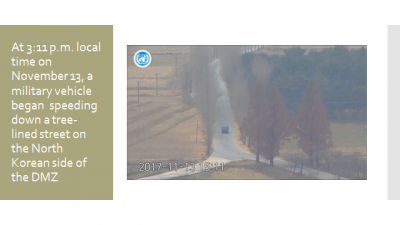

At 3:11 p.m. local time on 13th November, a military vehicle began speeding down a tree-lined street on the North Korean side of the DMZ. It moved past a North Korean guard post ahead of the bridge at 3:13 p.m. Bridge guards are confused but Oh rushes past and crosses the bridge. Oh approaches a monument to Kim Il Sung. Oh turns right at the monument, just steps away from South Korea. Under the cover of trees, Oh appears to stop and North Korean soldiers begin to move. Oh gets out from the driver’s side of the vehicle and starts to run while his former comrades start to shoot.


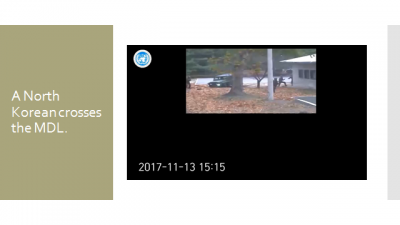
A North Korean crosses the MDL, a violation of the armistice. Later, Colonel Chad Carroll, US Forces Korea Public Affairs Director, clarified that the armistice was still in place.
At 3:43 p.m., Oh is lying by a wall on the South Korean side: he is safe.

Some interesting things about Oh is that he is the third member of the North Korean armed forces to defect this year. More than 40 bullets were fired at him, from pistols and an AK-47. Oh lost more than 50% of his blood by the time he arrived by air at Ajou University Hospital. Four major wounds were found, but he could have been shot twice in the same location. During treatment, Oh was given four pints of blood and multiple surgeries. At one point, doctors considered amputating his left arm due to nerve damage. His intestines and motor functions are also permanently damaged. On top of all of this, Oh was also found to have dozens of parasites, some as long as 27 centimetres, in his ruptured intestines, which may be reflective of poor nutrition and health in North Korea’s military. This is the desperation of one soldier – a man who has sworn his loyalty to the Supreme Leader of North Korea – risking his life by driving through the most heavily guarded border on earth.’
